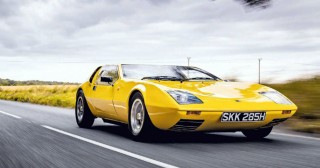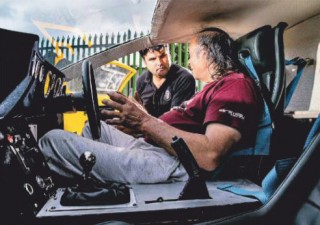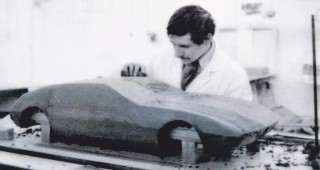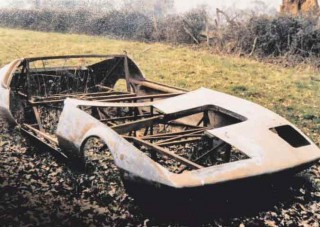Life Cycle
The remarkable life of the unique Gilbern T11 prototype, left unfinished after the factory closed Unlikely life of the Gilbern T11 Unfinished, abandoned, crashed, resurrected – the miraculous Gilbern T11’s life
1969 – Gilbern plots an all-new sports car
In 1969, the board of Gilbern Cars held a meeting to plan a small sports car to supplement its bigger Ford V6-engined Invader range of grand tourers. Various ideas were bandied about, with physical dimensions and engine sizes decided upon, although the decision whether to make the new car front- or mid-engined hadn’t been made yet. Gilbern Cars owner Roger Collings contacted TVR and Elva GT160 stylist Trevor Fiore, who was living in Spain at the time, and persuaded him to move to Wales to work on ‘Project T11’, Collings even providing Fiore with a cottage in Cardiff to stay in.

However, the working relationship between Collings and Fiore was difficult. Collings envisioned a beach-buggy-like sports car, and only finalised the mid-engined layout relatively late in the design process, whereas Fiore’s eventual design was a classic low-slung, long-nosed mid-engined wedge, hinting at TVRs to come.
‘I just wanted something that would be reliable – not a Rover K-Series engine from an MGF’
The prototype was scheduled to be completed in time for the 1971 Geneva Motor Show with a view to a 1972 launch, but fears that impending American safety legislation would demand crash protection stalled the project. Three bodyshells, built by Specialised Mouldings of Croydon, sat undeveloped at the factory after the project was officially abandoned in April 1971. It had already eaten £60,000 and the projected £1700 price of a production T11 was considered exorbitant – more than a Triumph TR6.
A combination of the 1973 imposition of VAT legislation, scuppering Gilbern’s ruse of supplying cars in part-built form to avoid purchase tax, then the Arab-Israeli war precipitating the international oil supply crisis resulted in the V6-engined mainstays of the Gilbern range becoming regarded as both too expensive and too thirsty for the market to sustain. Before Gilbern closed its factory doors in March 1974, T11 bodyshell number one had been cut up to create glassfibre repair sections for customers’ cars.

However, the parts created for the T11 project were not completely destroyed. One reason for this may be the recently unearthed business study casefile, commissioned by Gilbern in 1973 in the immediate wake of both VAT imposition and the oil crisis, which suggested that the T11 project may be looked at again in future, offering as it did a new, more modern direction for the firm to take.
The potential for at least one T11 to emerge from the ashes of Gilbern remained. In 1970, racing driver Terry Sanger had developed a tubular spaceframe chassis for the T11 with a mid-mounted 1.5-litre Austin Maxi engine, hidden beneath a cut-down Genie bodyshell held on with G-clamps, at GS Cars in Bristol and tested it at Castle Combe. ‘The steering and front wishbones are not attached properly,’ Sanger wrote in the testing notes he sent back to Gilbern with the chassis in late 1970. Thankfully, revisions were made, and Sanger re-tested the chassis and signed it off. Three chassis were built to Sanger’s specifications. The dismembered remains of chassis one and three were later found in hedges on Wickhurst Farm in Kent, after an agreement between the owners’ club and the farmer to use his barn for storage ran out. However, chassis number two was fitted with an engine and gearbox from an Austin Maxi and run around the factory grounds before the project was abandoned a few months later.
1976 – Work begins again in Pontypool
‘I was a 17-year-old apprentice at Park Gates Garage in Pontypool in 1976,’ recalls mechanic John Trett, ‘and after Gilbern went bust, all their old spare parts came to us because we used to do a lot of work for them. Our boss, Robert Gauntlett, raced and hillclimbed a Gilbern Genie, which I used to work on.
‘When I bought it the glassfibre was so badly delaminated, it came apart in my hands’
‘In among these parts was a complete T11 bodyshell, which two of our guys worked on, mounted on a chassis frame.’ Those two men were Gilbern Owners’ Club members Mick Davies and Nick Finlayson. The bodyshells as supplied by Specialised Mouldings had no apertures for opening doors, and needed extensive structural strengthening before they could be used on a car. Park Gates Garage sold the project to the Gilbern Owners’ Club president Martin Ingall for £250, who in turn sold it to Dave Lewis, an RAF electronics engineer stationed at Brize Norton, who stored the remains of the car but left it untouched for 12 years.
2000 – Gordon Johnston tracks down the T11
‘I’d gone up to York on the National Express to buy a MkII Invader,’ says motor engineer, Egyptologist and Gilbern enthusiast Gordon Johnston. ‘The owner lived in a beautiful old coach-house, I stayed the night before driving back in the Invader, and before I set off the next morning he gave me a pile of Gilbern Owners’ Club magazines to go with it. In one of them was a black-and-white photo of the T11 prototype. I rather liked the look of it and wanted to know more.

‘Roger Franland, the Owners’ Club’s spares secretary, said he knew where it was – down in Dorset, where someone had bought it from Dave Lewis via the club in 1988 but done nothing with it.
‘I contacted that Dorset-based owner, Dave Jones, asked him whether he wanted to sell it, and he said no. However, a few months later, he agreed to sell, and a few weeks later I brought it up to my father’s bungalow on a trailer behind a Range Rover. ‘My father took one look at it and simply said, “Gordon, what have you bought?”
‘Neither Dave Lewis nor Dave Jones had done much with it, but Lewis had at least completed the bodyshell, using bits of wood and extra glassfibre to strengthen it. However, when I bought it, the glassfibre was so badly delaminated it started coming apart in my hands. I showed it to a friend of mine, a glassfibre specialist from Thanet, who said it was unusable. ‘Most bits of the car were rubbish, but there were two Austin Maxi engines supplied with it. The one installed, a 1750, was a non-runner, but the original Downton-tuned 1500 – the only one Downton built – was included, with a lightened and balanced crankshaft, ported cylinder-heads, bespoke manifolds, Vernier cam pulley and twin carburettors.
‘I first got it going at work – Ebdens Garage in Deal, Kent – and it was then that I discovered the strange position of the gears. What I thought was first gear was sluggish, and changing into second made it stall. ‘Gilbern had taken a very early Maxi with a rod-and-cable gearchange, stripped it down, and installed the engine and gearbox in the back of the T11 chassis.

However, they had no experience of adapting a transverse front-wheel-drive engine and gearbox for mid-engined operation. Control of the gearbox was via a series of rods, with first, second, third and fourth on one side and fifth and reverse on the other. It ended up with first where fourth is on most cars, second where third usually is, third where second is, fourth where first typically is but fifth in the usual place on the opposite top right-hand side of the gate! ‘Absolutely everything needed doing, but the bodyshell was most pressing.
I needed a new one moulding because the existing one was unusable, so in 2006 I contacted Dave Lewis, who had taken a mould from it but didn’t want anyone making any more than one and creating replicas. We found a boat-builder in Wales who agreed to make just one bodyshell for the project. With that made and fitted, I still had the fun of making the doors. Bearing in mind that there were no door panels or suggestion where they’d be, no dashboard, no wiring loom, no lights…
‘It was at this point that I emailed Trevor Fiore to get some idea of what it was supposed to be like. He replied a few times, but said that his fall-out with Gilbern meant he didn’t want have any involvement – he had actually walked away from the project at the clay-model stage.

‘So I got out paper and pencils, and set about making internal trim panels out of cardboard, then using them as templates to make solid models from wood. I used the outer door-skin shape to get the internal door shape right. The process took ages, after work on freezing winter nights.
‘Once the bodyshell was fitted, the apertures cut and internal structure built, I had it painted by Larry Smith. It’s a toned-down, hand-mixed Audi colour. The original bodies were never painted – Gilbern never got around to it – and although the company had a basic set of colour schemes, they also offered to mix any shade for you, so it followed tradition!
‘I finally got it on the road in May 2009. The DVLA in Maidstone was very helpful in getting it registered as was Roger Collings, who supplied a letter of authentication, resulting in an age-related numberplate rather than a Q-plate. It was registered within a week, just in time for the 50th anniversary celebrations of Gilbern – and the 40th of the Owners’ Club – held at the Shuttleworth Collection at Old Warden Aerodrome in Bedfordshire. I took it up there on a trailer – the registration papers only arrived the day before, and I didn’t know if it would make it up there if I drove it!

‘Over the next two years I never went very far in it, just to local classic car shows. Changing gear was a right pain and certainly limited its driveability. But in 2011, disaster struck. The T11 was struck by a lorry on the M20 in Kent and the driver didn’t stop, instead driving off in the direction of Dover – so I couldn’t get his insurance details.
‘It just looked like the lorry had left tyre marks on the body, but it had actually pushed a rear wheel inwards, smashing the differential off the gearbox. The Maxi engine is like the Mini’s, with the gearbox in the sump, so the engine lost all its oil. I suppose it put paid to the gearbox issues, but the unique powertrain was wrecked. Tired of it, I put the car in my lock-up and left it while I worked out what to do with it.

‘After four or five months, I tried to find a replacement gearbox, but nobody had one other than the spares secretary of the Maxi Owners’ Club, who just had one Gold Seal item in its original box and wasn’t prepared to part with it.
‘So I went for Toyota power. I just wanted something reliable – not a Rover K-series engine from an MGF. I bought a MkII MR2, and its engine and gearbox stayed in the T11 for three years. But they were too heavy and made it tail-happy. It’s had a 2ZZ unit from a Corolla T-Sport for close on four years now, coupled to a six-speed gearbox from a two-litre diesel, so now 70mph comes at 3200rpm rather than 3435rpm. ‘I’ve won a couple of trophies with it, including Best In Show at Motoring at the Manor [the inaugural Welsh concours d’elegance held at Celtic Manor in summer 2019]. But most people just don’t know what it is. I’m not really after trophies; I just want to tell people about Gilbern and the T11.
‘It’s my only car now. I even go down to Aldi in it from time to time to do my shopping, and get some funny looks. I’m restoring an aircooled VW Beetle now so I’ll have something more sensible eventually to go alongside it, but the town centre’s within walking distance and I don’t like modern cars – I’ve been fixing them for 52 years, after all.’

1970: the Gilbern T11 takes shape in clay-model form, with several key details still unknown.
1971: one of the body-less Terry Sanger chassis is taken for a run. After an uncertain birth, 24 years abandoned and an altercation with a lorry, the sole T11 is now on the road.
1973: bodyshells scavenged for glassfibre during Gilbern’s last days.
1970s: remains of the T11 project are barn-stored at Wickhurst Farm in Kent.
2000: although holes were cut, lights had never been fitted
2000: 0ne of Gordon Johnston’s challenges was to give the car working doors.
2000s: original Downton-tuned Maxi engine made a comeback.
2000: Gordon Johnston gets to work. Three powerplants have called the engine bay home: an experimental Downton-BMC 1500, and Toyotas 3S-GE and 2ZZ. Air ducts are a relatively new addition in the ongoing task of engineering the T11 50 years on.
2006: original bodyshell was too far gone, one new moulding was sanctioned.
2007: Audi colour and headlights in place, but internal architecture is all down to Gordon. Gordon Johnston explains why the T11 works as his only car.





